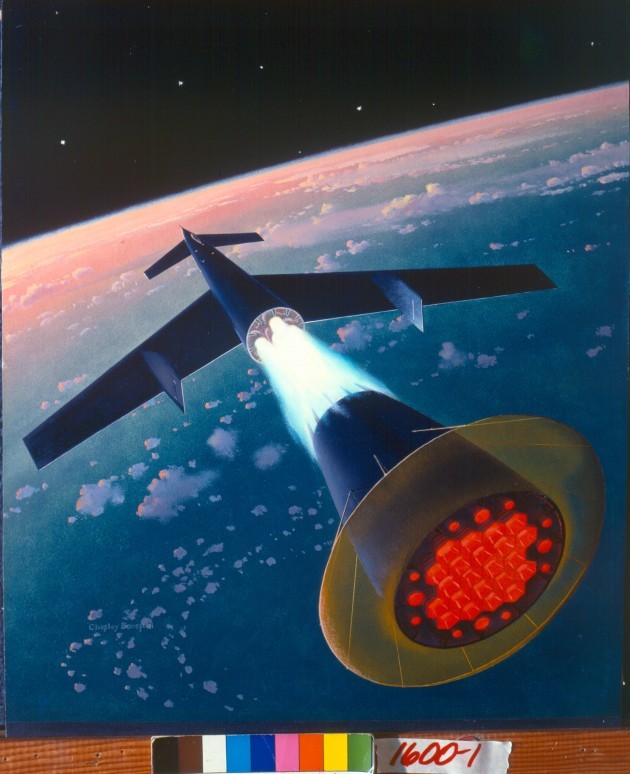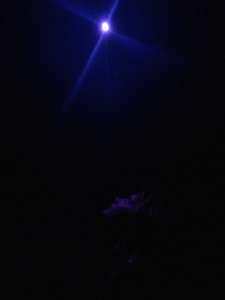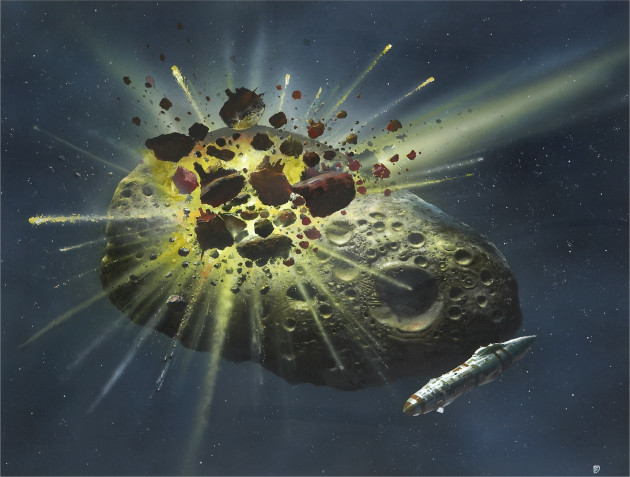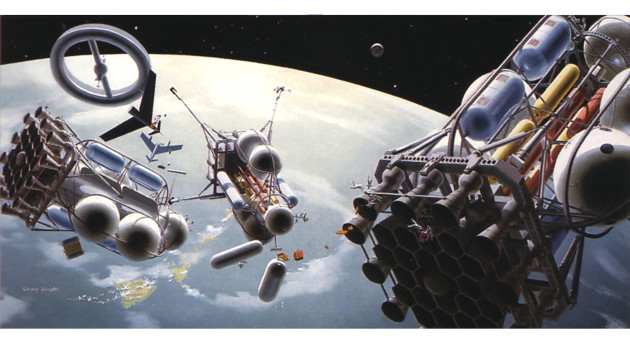Geek Life: Fun stories, memes, humor and other random items at the intersection of tech, science, business and culture. Space-suited workers assemble a two-passenger-ship and single-cargo-ship lunar expedition in Earth orbit, c. 1952 (Chesley Bonestell © Bonestell LLC).
More than 50 years ago, an event in Seattle changed the world forever. The 1962 World’s Fair got 10 million visitors excited about science and technology. One of those visitors was Paul Allen, who went on to co-found Microsoft, Vulcan Inc., Stratolaunch Systems, and more.
Paul Allen
Allen says the World’s Fair inspired his love of technology and passion for aerospace. Over his lifetime, he’s amassed a vast collection of art and artifacts that celebrate that passion.
Now Allen is putting those artifacts on display, in the hopes of inspiring a new generation. The exhibit, called “Imagined Futures: Science Fiction, Art, and Artifacts from the Paul G. Allen Family Collection,” opens April 7 at Pivot Art + Culture, a concept space in the recently opened Allen Institute building in Seattle’s South Lake Union area.
The gallery opened in December, with an exhibit called “The Figure in Process: de Kooning to Kapoor 1955-2015.” Until recently, no additional art exhibitions had been announced, causing speculation about the space’s uncertain future. Now it appears Pivot Art + Culture will continue to function as an art gallery, at least until this exhibit closes in July.
“Last Fall, we shared that the initial model for Pivot Art + Culture was being evaluated and long-term options other than a gallery space are being considered,” a Vulcan spokesperson told GeekWire. “There may be subsequent exhibitions, or it may be used for something other than a gallery. Paul Allen’s commitment to arts and culture includes exploring different models for elevating and enriching arts in the NW.”
The “Imagined Futures” exhibit features 60 items inspired by Allen’s childhood memories of the space race. GeekWire caught up with the exhibit’s curator, Ben Heywood, to learn more about the project. Continue reading for our edited Q&A.

Bob Eggleton, c. 1993 (Bob Eggleton(c) 1993 for ANVIL OF STARS based on the book by Greg Bear).
Bob Eggleton, c. 1993 (Bob Eggleton(c) 1993 for ANVIL OF STARS based on the book by Greg Bear).
Heywood: We’re drawing from the collections the Paul G. Allen family collection but we wanted to look at how artists had, over 60 years or so, envisioned the future. I think one of the great tasks, or one of the exciting things about art and artists, is they help us understand and help us to imagine to envision the unimaginable and the unknown.
What we tried is a combination of technological and engineering envisioning — so the work of someone like Fred Freeman, where he’s working with a rocket engineer like Wernher von Braun, to visualize what America going into space will actually look like. Then compare that with the more contemporary science fiction illustrators like Jim Burns or Chris Foss or Bob Eggleton who try to create images show us what a far future might look like and then also combine that material with more traditional artists — someone like Simon Norfolk or Thomas Ruff who are, again, about envisioning technology or recording technology and showing us what the future looks like.

GW: Can you talk about some of the artifacts and art that will be in the exhibit?
Separation of the third stage from the second stage of the reusable von Braun launch vehicle system, c. 1952 (Chesley Bonestell, © Bonestell LLC).
Separation of the third stage from the second stage of the reusable von Braun launch vehicle system, c. 1952 (Chesley Bonestell, © Bonestell LLC).
Heywood: Along with the two-dimensional work we have a set of commissioned models that were produced for an exhibition a number of years ago that were looking at these envisionings of the space race. These are models that are based onWernher von Braun, Chelsey Bonestell, Fred Freeman, images of space technology.

We also have quite a rare piece, which is a model — so Chelsey Bonestell, who is a very, very famous artist of the space race — would produce models and then place them in model landscapes and then he would paint those models and those landscapes. So we have a model of his, the Voyager One space probe, placed in this kind of plaster moon landscape and that’s what he would then paint in order to create his images.
What we wanted to do was try and show the breadth of the Paul G. Allen collection and so we have an IBM 360 computer server panel from the Living Computer Museum. That’s dated right around 1968 and is one of the panels that would have been used to run a NASA mission in the late 60s and early 70s. We also have an XLR 99 Rocket Motor from an X-15 NASA hypersonic plane. The X-15 NASA hypersonic plane was a project of Walter Dornberger, who was Wernher Von Braun’s boss in the German Rocket group in WW2. Both immigrated to the US after the war as part of Operation Paperclip, which gave the U.S. an unassailable lead in space exploration research
